- Home
- Reefing a Sail
- Single Line Reefing
- Jiffy Reefing
Is Jiffy Reefing the Simplest Method of Reefing the Mainsail?
I unashamedly admit that jiffy reefing, or slab reefing as it's also known, is my choice of mainsail reefing system. Simple, efficient and reliable - the essence of a seaworthy system.
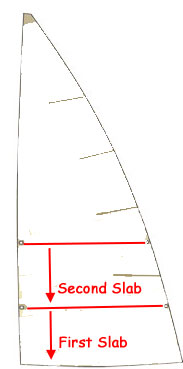
The jiffy reefing system reduces the mainsail area from the foot of the sail in a series of parallel 'slab's—normally three—a process involving a number of control lines:
- the main halyard;
- the topping lift;
- the vang (or kicker);
- the reefing line(s).
It makes reefing the main a whole lot easier if all of these these terminate in one of two locations—either at the mast or in the cockpit, so that one crewman can complete the whole operation without assistance.
1. All lines at the mast: The downside of this arrangement is that it involves the greater risk. Going forward in deteriorating conditions is best avoided if at all possible.
2. All lines led aft to the cockpit: Much the safer alternative, but the price of this arragement is that there's more friction in the system and a lot more lines in the cockpit.
On this page:
A common, but in my view less than ideal arrangement, is where the reefing lines are led back to the cockpit, but the halyard and the reefing cringles have to be dealt with at the mast - the worst of both worlds.
Either two people must be involved or, one person having completed the luff reefing process at the mast must leave the sail flapping while he gets back to the cockpit to pull down the reefing lines for the leech of the sail.
Timing Matters:
Reef before you need to. If the wind is picking up and you’re debating whether to reef, do it now. Waiting too long can make the process dangerous.
If sailing with a crew, establish clear roles. One person should handle the halyard while another manages the reefing lines. Communication is key—use hand signals or pre-agreed commands to avoid confusion.
The Mechanics of Jiffy Reefing
1. With all lines at the Mast
Let's say that you've got your mainsail halyard and reefing lines at the mast. Here's how to put a reef in:
Before Leaving the Cockpit:
- Head-up into wind;
- Ease kicking strap;
- Ease mainsheet.
At the Mast:
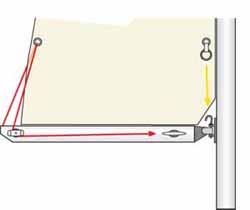 All control lines at the mast
All control lines at the mast- Take-up on topping lift;
- Drop mainsail far enough to enable the cringle to be hooked over the reefing hook (or cowhorn);
- Hoist main and secure;
- Pull in leech reefing line and secure;
- Ease topping lift;
- Coil and secure all ropes, then skip smartly back to cockpit;
- Get back on course and trim sails. Job done!
Flying Cringles & Captive Hooks
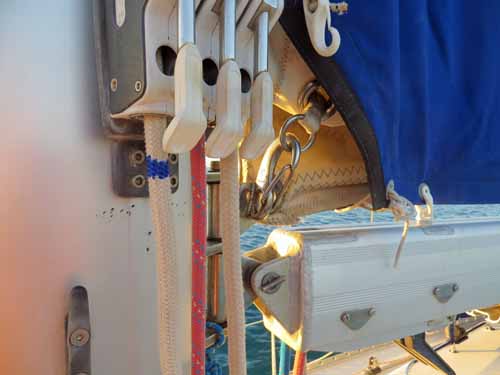 Mainsail Halyard marked just below the jammer
Mainsail Halyard marked just below the jammerReefing a sail at the mast - particularly on wet and windy night - isn't everyone's idea of fun, so anything that can be done to make the job easier is worth knowing about:
- Mark the main halyard just below the jammer at the point where the cringle can hooked over the cowhorn. Do this for each reef position;
- Use flying cringles on short lengths of webbing straps. This makes it much easier to hook over the cow horn. Flying cringles are attached to the sail's luff reefing point with a short length of strong webbing. This webbing creates a larger, more forgiving loop, making it much easier to quickly slip over the gooseneck's reefing hook. This simple addition can significantly reduce the fumbling and frustration, especially when conditions are less than ideal.
- Replace standard cowhorns with captive hooks, so the flying cringle can't fall off before you haul in on the halyard.
- Use Dyneema for reefing lines. Dyneema is a high-strength, low-stretch material that reduces friction in reefing systems. It’s more durable than traditional polyester lines and makes reefing smoother.
2. All lines led aft to the cockpit
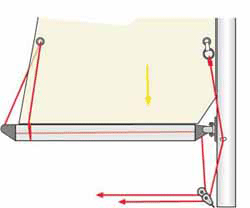 A 2-line reefing system
A 2-line reefing systemWith this arrangement the mainsail halyard and the topping lift will be brought back to the cockpit through turning blocks at the foot of the mast, and the task of hooking the sail cringles over the reefing hooks on the gooseneck is eliminated.
Two separate reefing lines are used for each reef; one pulls down the leech of the sail and the other pulls down the luff.
So if you've got three sets of reef points in your mainsail, that's six extra lines in the cockpit. Hmmm.
But the resulting snakepit can be avoided with a single line reefing system for each slab which will reduce the lines to three, or the somewhat complicated cascading system which will get it all done with just one single reefing line.
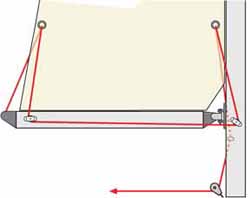 A single-line reefing system
A single-line reefing systemHow It Works:
Instead of separate lines for the luff and leech, a single line runs through a series of blocks inside the boom. When pulled, it reefs both the luff and leech simultaneously.
Advantages:
- Less cockpit clutter—fewer lines to manage.
- Easier for single-handed sailors—no need to juggle multiple lines.
- Reduced friction—modern systems use low-friction blocks to improve efficiency.
Interested? Then may I suggest you take a look at:
Is Single Line Reefing Right for Your Sailboat?
Alternative Mainsail Reefing Systems
Whilst jiffy reefing (aka slab reefing) is a popular choice, how does it stack up against other mainsail reefing systems? There are two other primary alternatives: in-mast furling and in-boom furling. Each has its own advantages and drawbacks.
In-Mast Furling
This system allows the mainsail to be rolled into the mast, making reefing effortless and eliminating the need for reefing lines. However, it comes at a cost—literally. In-mast furling is expensive to install and can compromise sail shape, reducing performance. Additionally, if the sail jams inside the mast, it can be difficult to fix at sea.
In-Boom Furling
Instead of rolling the sail into the mast, this system stores it inside the boom. It offers better sail shape than in-mast furling but still introduces mechanical complexity. Like in-mast furling, it requires specialized equipment and can be prone to jamming.
More about these mainsail furling systems...
Reefing Risk & Safety
You won't need me to tell you that sailing is by nature a risky business. Safety is about avoiding risk taking where possible and minimising their likelihood and impact of occurence where it isn't.
So, while the mechanics of reefing the mainsail are important, getting the reef in safely is paramount. Before even contemplating a trip to the mast, or engaging a cockpit-led system, always prioritize personal safety. This means wearing a lifejacket – no exceptions – and ideally using a tether to remain clipped onto the boat, especially if heading forward in bouncy conditions.
Before making any sudden moves, take a moment to assess the sea state and wind conditions. Waiting for a lull in a gust or a calmer period between waves can make all the difference in executing the reef safely and efficiently.
Even if your boat is equipped for cockpit-led reefing, unexpected snags or issues might necessitate a trip to the mast, so always be prepared. Remember, minimizing time spent at the mast in adverse conditions is always the goal. Should a line snag or a sudden gust hit while you're in the midst of reefing, the most important thing is to remain calm.
If a line snags, try to ease the tension on it if possible, and don't force it.
If a gust hits, just like with any sail handling, head into the wind slightly to depower the sail and reduce the load, giving yourself more time and control.
Maintenance & Inspection
Your jiffy reefing system, like all boat hardware, requires regular attention. Make it a habit to inspect all reefing lines, cringles, and associated hardware periodically. Look for signs of chafe on the lines, especially where they pass through blocks or clutches, and check for any UV degradation, which can weaken the line over time. The metal cringles on the sail should be free of sharp edges that could abrade the lines, and the reefing hooks or cowhorns should be secure and free of corrosion. Furthermore, don't forget the blocks and sheaves!
Regular lubrication of blocks and sheaves with a dry lubricant designed for marine use will significantly reduce friction, making it much easier to pull in and ease lines, especially in cockpit-led systems.
Finally, pay attention to the sail fabric around the reefing points. These areas are under significant stress when reefed, so inspect them for any signs of tearing, fraying, or damage, particularly after heavy use. Addressing small issues early can prevent larger, more costly repairs down the line.
Sail Shape & Performance
A well-reefed sail is not just about reducing sail area; it's about maintaining an efficient sail shape. When you pull in a reef, you're not just making the sail smaller; you're also shifting the center of effort lower and slightly aft, which helps reduce heeling and improves directional stability.
To achieve this, it's crucial that both the luff and the leech of the reefed sail are properly tensioned. A taut luff ensures the sail is flat and efficient in the crucial leading edge, while a taut leech prevents the sail from twisting excessively, which can lead to unnecessary drag and a loss of drive.
Understanding this relationship between reefing and sail shape is key to getting the best performance and comfort from your boat in stronger winds.
Recent Articles
-
Ericson Sailboats: History, Models & Buying Guide for Used Yachts
Jun 30, 25 02:18 PM
Explore the legacy of Ericson sailboats! From their Bruce King designs & solid fiberglass construction to popular models like the Ericson 28.5 & 39, get insights for buying used Ericson yachts. -
Elan Sailboats: Quality & Comfort for Cruising & Performance
Jun 30, 25 01:35 PM
Discover Elan yachts: blending exhilarating performance with onboard comfort. From robust construction using VAIL technology to versatile layouts, find out why Elan sailboats are a top choice for recr… -
Dufour Yachts: Explore Models, History & Performance
Jun 30, 25 03:39 AM
Discover Dufour sailboats! From the classic Dufour 2800 to modern Grand Large yachts, learn about their French heritage, design philosophy, construction, and what makes them ideal for recreational cru…












